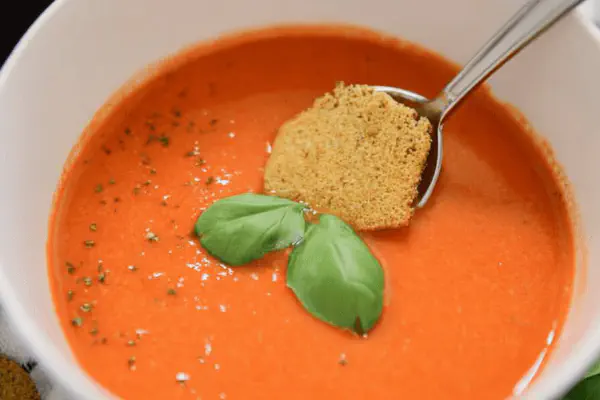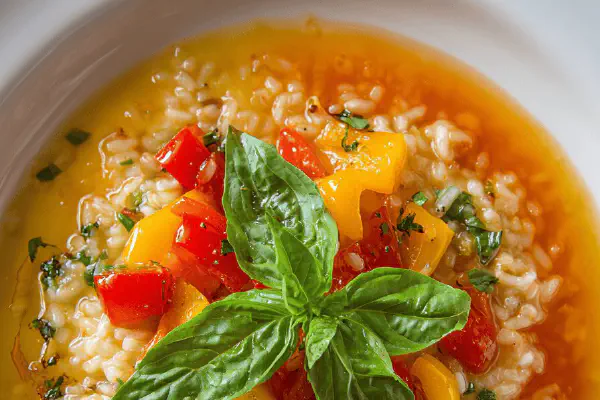Oven-Roasted Tomato Bisque

By Emma
Certified Culinary Professional
Ingredients
- 9 large beefsteak tomatoes halved, seeds removed
- 2 medium shallots quartered
- 3 cloves garlic unpeeled
- 3 tablespoons olive oil
- 1 teaspoon smoked paprika
- 750 ml vegetable broth approximate
- fresh tarragon handful
- salt and black pepper to taste
- optional splash coconut milk or heavy cream
About the ingredients
Method
- Position oven rack close to broiler element. Preheat broiler on high.
- Toss tomatoes, shallots, garlic cloves, olive oil, smoked paprika and some black pepper in bowl. Spread evenly on rimmed baking sheet.
- Roast vegetables under broiler 10–12 minutes until skins bubble and blacken in spots. Smell shifts smoky and sweet.
- Cool slightly; peel tomato skins off—should slip away with little resistance.
- Discard garlic skins, squeeze softened garlic from cloves.
- In heavy saucepan, bring vegetable broth to gentle simmer. Add roasted tomatoes, shallots, garlic, and fresh tarragon stems.
- Simmer uncovered 15 minutes, vegetables should fall apart easily, broth smelling herbaceous and rich.
- Remove tarragon stems, transfer hot soup in batches to blender. Pulse briefly to keep some texture; avoid pureeing to total smoothness.
- Return soup to pot, adjust thickness by adding stock if too thick. Taste for seasoning; add salt and pepper gradually.
- Optional: stir in splash of coconut milk or cream for mellow sweetness and texture.
- Serve hot with crusty bread. Garnish with chopped tarragon or drizzle olive oil if desired.
Cooking tips
Chef's notes
- 💡 Roast tomatoes close to broiler, skin bubbles and chars in spots. Look for blistered skin pulling away easily. Smell shifts smoky sweet not burnt. Timing varies but 10 to 12 minutes typical. Cooler tomatoes resist peeling. Pull skin while warm, use fingers or knife edge gently.
- 💡 Skip pureeing to baby-food smooth. Pulse blender in batches, keep some chunks for texture and mouthfeel. Too long blending kills rustic feel. Blend hot soup carefully, batches avoid overheating blender motor and temperature spike. Add broth to adjust thickness gradually, soup should coat spoon without stiffness.
- 💡 Use smoked paprika instead of celery salt. Adds warmth without salt’s sharpness. Toss with olive oil and shallots before roasting for caramelization. Garlic roasted whole softens, squeezing out spreadable flesh. Minced garlic burns quickly under broiler, avoid it.
- 💡 Fresh tarragon stems simmered infuse lightly, remove before blending to prevent bitter notes. Dried tarragon is okay but add early to extract flavor. Coconut milk tames acidity, heavy cream gives richer mouthfeel. Stir dairy in slowly on low heat to prevent separation or curdle.
- 💡 Use quality extra virgin olive oil. Low-grade oil masks flavor layers, good oil carries through roasted aroma and fresh herbs. Salt and pepper added at end after blending calibrate seasoning precisely. Taste warm soup slowly; hot temps dull salt perception. Season gradually, adjust when cooled slightly.
Common questions
Can chicken stock be used?
Yes, but chicken stock adds fat and masks brightness. Vegetable broth cleaner. If using chicken, reduce or strain fat. Flavor shifts richer, less tomato focus.
How to know when tomatoes are ready?
Skin should blister, bubble, blacken slightly. Smell turns smoky and sweet; crackling edges. Visual cues count more than clock. Timing differs based on tomato size and oven power.
What if soup is too acidic?
Add splash coconut milk or cream. Both balance acidity. If no dairy, try small pinch sugar but avoid oversweet. Acid sharpness usually from tomato skin or cooking time; tweak roasting duration next time.
How to store leftovers?
Refrigerate covered few days max. Soup thickens; stir in broth when reheating if too dense. Freeze in portions, thaw overnight fridge. Reheat gently low heat. Avoid rapid temp changes spoiling texture.



